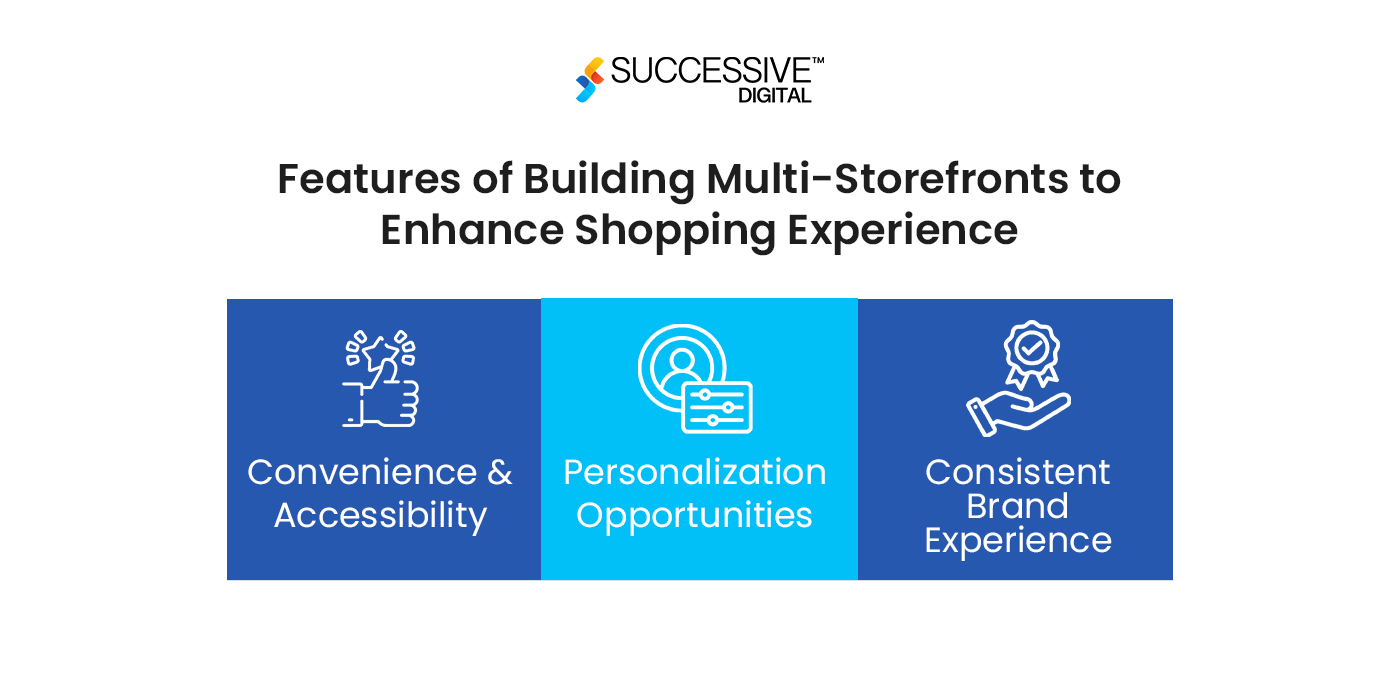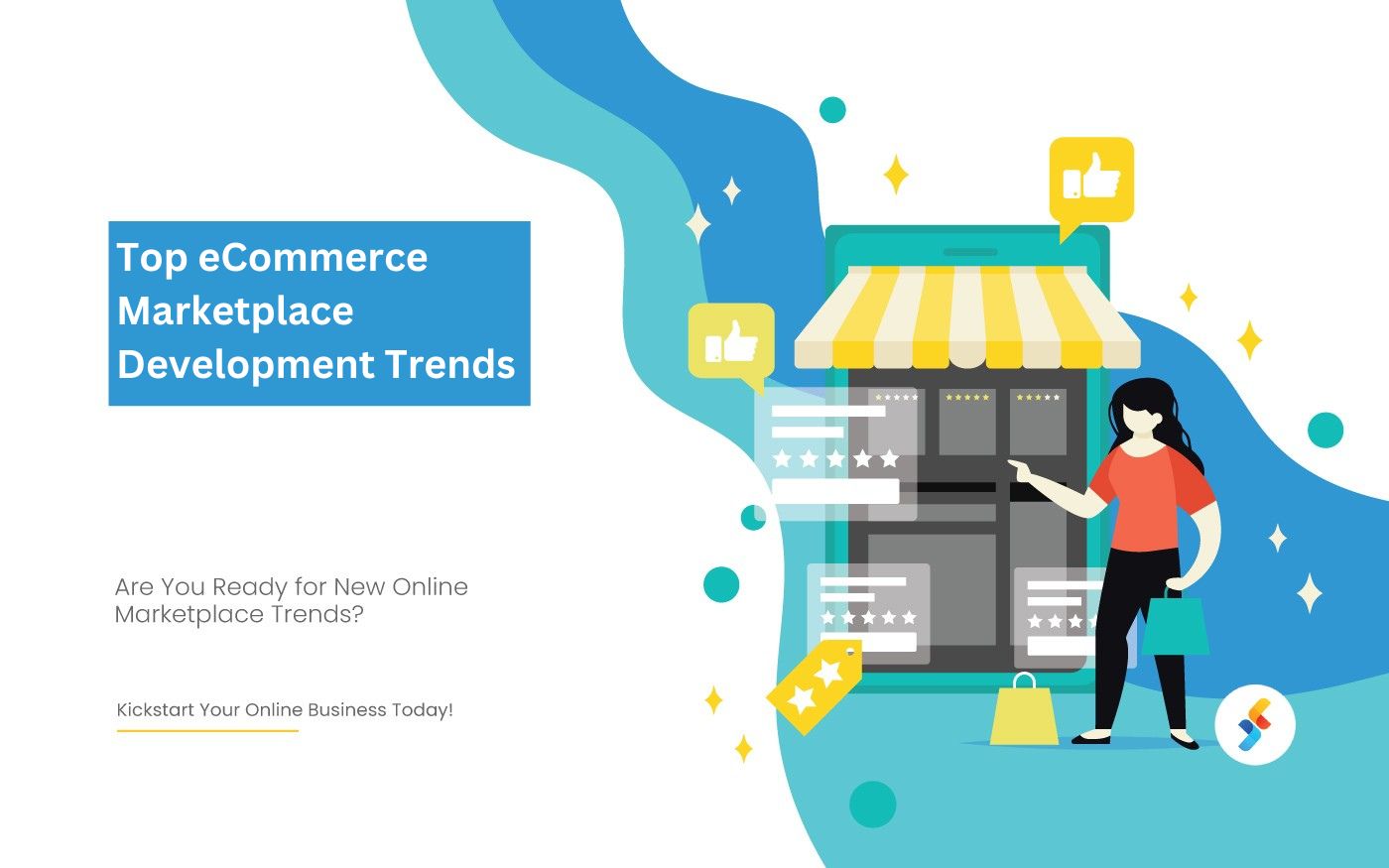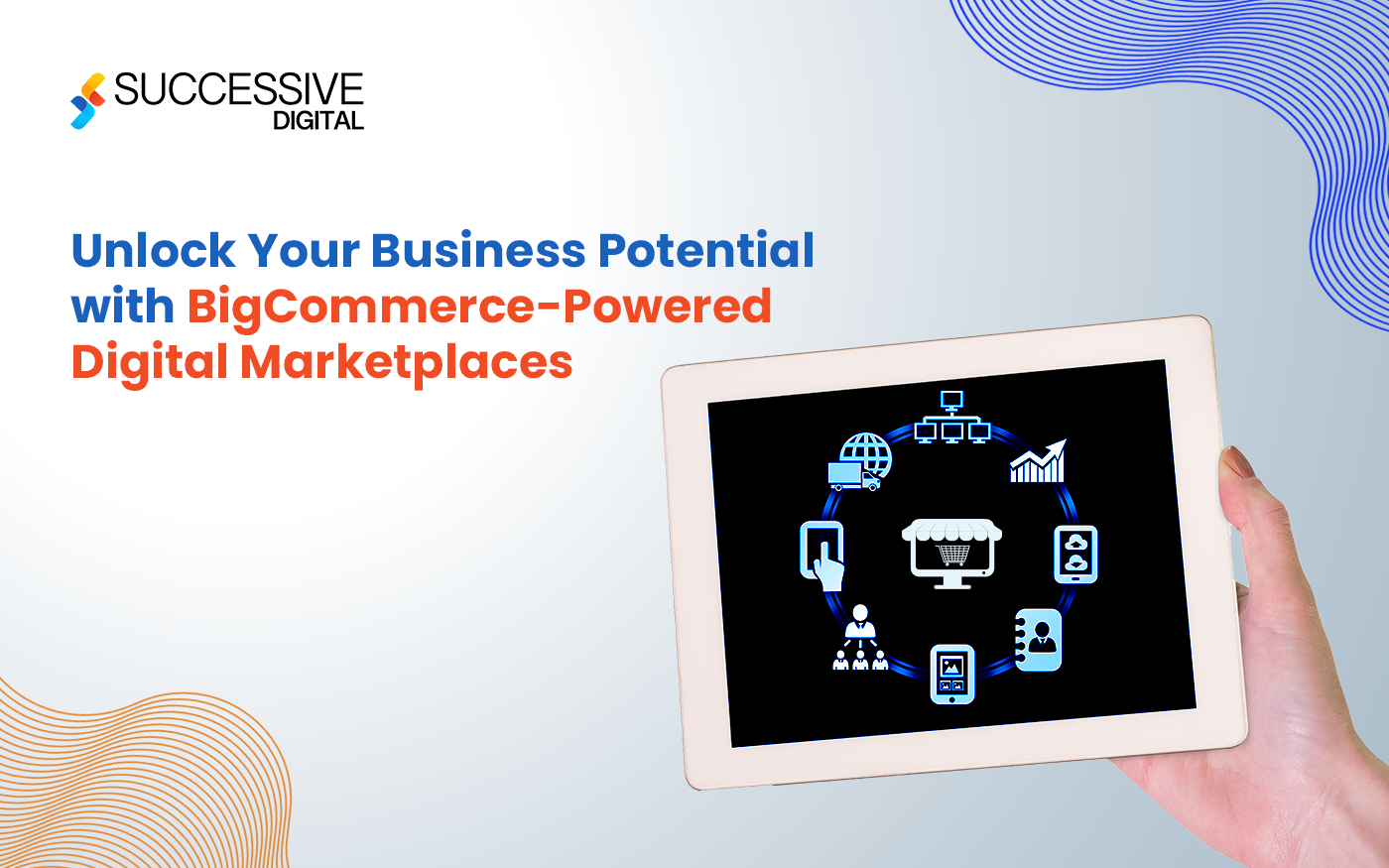We are living in an era where convenience and personalization are not just a necessity but an essential strategy for every business looking to capture the attention and loyalty of modern customers. This strategy is also implemented in eCommerce and hence birthed personalized commerce. This approach tailors the shopping experience to individual preferences, offering a unique and engaging journey for each customer. Embracing personalization has enabled brands such as Amazon and Flipkart to manage multiple sales channels – different websites, marketplaces, or even physical locations from a single eCommerce backend.
BigCommerce, a robust eCommerce platform, stands at the forefront of this approach and allows businesses to build, optimize, and manage multiple stores from a single BigCommerce backend repository. Moreover, it offers several solutions for businesses aiming to embrace personalized commerce.
This comprehensive guide will discuss the significance of personalized commerce and how building BigCommerce multi storefronts can assist you in expanding your brand reach across international markets.
Understanding Personalized Commerce
Personalized Commerce involves tailoring every aspect of the customer’s journey, from product recommendations to push notifications, based on individual preferences, purchase behaviors, and past interactions. This level of customization is designed to create a unique and tailored shopping experience for each customer, enabling a strong connection between the consumer and the brand.
To implement personalization, leveraging BigCommerce multi storefront can be a helpful solution.
The Impact of Personalized Experiences on Customer Satisfaction
Personalized shopping experiences have a lasting impact on customer satisfaction. Personalization makes customers feel that a brand understands their needs and preferences personally. This enhances their satisfaction and enables businesses to build stronger connections with them.
Personalization is not merely a marketing tactic; it is a means of building a long-term relationship with the customer. By delivering relevant content, recommendations, and promotions, businesses can create a sense of value and connection, ultimately translating into long-term customer relationships. You can consult a trusted BigCommerce Migration Partner to set up multiple storefronts for each facet of your business.
Examples of Successful Personalized Commerce Implementation
By adopting diverse and innovative approaches to eCommerce personalization, businesses like Amazon, Spotify, and Netflix have not only increased customer engagement but have also witnessed a substantial boost in revenue. From AI-powered, tailored product recommendations and targeted marketing campaigns to customized user interfaces and push notifications, they have implemented personalization at every core of their operations.
By utilizing multi storefront BigCommerce capabilities, you can develop appealing storefronts–tailored for every audience, region, or segment. And the best part is, you can manage everything from a single dashboard.
The Role of Multi-Storefront Capabilities
Multi-storefront refers to the strategic approach of managing and operating multiple stores, websites, or physical channels from a single backend, facilitated by an eCommerce platform like BigCommerce.
This concept goes beyond the traditional single-store model, allowing businesses to extend their presence across international markets and engage with customers while offering each of them a tailored experience.
The significance of multi-storefront capabilities lies in its ability to adapt to the diverse ways consumers prefer to interact with brands today. It addresses the omnichannel nature of customer journeys, acknowledging that individuals may discover, research, and purchase products through different touchpoints such as online stores, mobile apps, social media, and marketplaces like Amazon and Walmart.
By leveraging multi storefront BigCommerce capabilities, businesses can seamlessly connect with customers across these diverse touchpoints. This flexibility empowers them to reach a wider audience, empower brand consistency, and stay competitive in an environment where consumer preferences tend to change.
How Multi-Storefronts Enhance the Customer Shopping Experience?

Implementing multi-storefront capabilities goes beyond merely expanding the digital footprint; it fundamentally transforms the overall customer shopping experience. Let us understand the role of multi storefront development in personalized commerce.
-
Convenience and Accessibility
Multi-storefronts provide customers with the convenience of accessing products and services through their preferred channels. Whether it’s an online store, a mobile app, or a social media platform, customers can seamlessly transition between different touchpoints, ensuring a frictionless and convenient shopping experience.
-
Personalization Opportunities
With multiple storefronts, businesses can gather valuable data from various touchpoints, allowing for a more comprehensive understanding of customer preferences. This data is generated by AI and ML algorithms, that enables your eCommerce website to provide personalized recommendations, creating a tailored experience for each shopper.
-
Consistent Brand Experience
It enables businesses to maintain a consistent brand identity across different channels. From the design and user interface to the overall user experience, customers receive a cohesive and recognizable brand experience, regardless of the touchpoint they engage with.
An Overview of BigCommerce Multi Storefront Capabilities
When we talk about digital transformation in retail, developing multiple storefronts is one of the imperative strategies businesses adopt to win more customers. However, the decision comes down to choosing the rightful eCommerce platform that can extend its support no matter what a business desires. In such a case, the expert BigCommerce development company recommends that enterprises must leverage multi storefront BigCommerce capabilities.
The platform offers various solutions to cater to the diverse needs of merchants, enabling them to create immersive and seamless shopping experiences. Each storefront is designed to empower respective audiences and allow them to easily navigate through the website and complete the purchase process in one go.
Multi Storefront BigCommerce Features: Enabling Personalized Commerce
According to a recent study, global eCommerce sales are estimated to increase by $6.3 trillion, by 2024. In addition to this, there were 2.14 billion digital buyers worldwide in 2021, and experts anticipate the number to increase to 2.41 billion by 2025. This explains that the businesses that invest in international commerce and build tailored storefronts will have a competitive edge over those that do not. Let us understand the role of BigCommerce in building multiple storefronts for eCommerce personalization.
Strategic Multi-Storefront Implementation
BigCommerce recognizes the importance of a strategic multi-storefront approach in modern eCommerce, where consumers seamlessly transition between online and offline channels. There are various features and tools within BigCommerce that facilitate the implementation and management of multi-storefront strategies.
Unified Management from a Single Dashboard
When you choose the BigCommerce multi storefront feature, you are positioned to manage all your storefronts from a single BigCommerce dashboard. Merchants can effortlessly navigate between different storefronts, streamlining operations and ensuring a cohesive brand experience across diverse channels.
Flexible Storefront Customization
BigCommerce enables businesses to create distinct storefronts tailored to specific audiences or geographic locations. This includes customization options for branding, product assortment, and pricing. This flexibility ensures that each storefront caters to the unique expectations of its target audience while maintaining brand consistency.
Integrated Analytics for Informed Decision-Making
To support the dynamic nature of multi-storefront strategies, BigCommerce integrates robust analytics tools and utilizes AI to generate data-driven insights. Businesses gain insights into the performance of each storefront, allowing them to make informed decisions and enhance customer experience. This data-centric approach also empowers merchants to refine and optimize their multi-storefront strategies for maximum impact.
Seamless Inventory and Order Management
Managing inventory and orders across multiple storefronts can be complex, but BigCommerce simplifies this process. The platform’s integrated inventory and order management system ensures that businesses can efficiently track and fulfill orders, minimizing operational challenges associated with running multiple online stores.
Personalized Commerce with BigCommerce’s Multilingual Support
When you choose to invest in multi-storefront development for different geographical regions, it means your website must support different languages to offer a personalized shopping experience to your regional audiences. BigCommerce multi language support enables you to integrate multilingual capabilities into your website so that every customer can interact with your products in their particular language. Based on the region, you can connect a distinct domain and SSL certificate within your store, customize default currencies, personalize transactional emails, optimize checkout experiences, and integrate payment options to streamline the purchase process.
Implementing BigCommerce Multi Storefront Strategies
Steps to Set Up and Manage Multiple Storefronts on BigCommerce
Creating multiple storefronts on BigCommerce is a strategic move to reach diverse customer segments and enhance the overall shopping experience. Here’s a step-by-step guide for businesses looking to set up and efficiently manage multiple storefronts:
Step 1- Understand Your Audience Segmentation
Identify distinct customer segments based on demographics, behavior, or preferences. Determine the unique needs and expectations of each segment to tailor BigCommerce multi storefronts accordingly.
Step 2- Account Setup
Once you determine your target audience and the respective segments, the next step is to set up your account and dashboard from where you will manage all your storefronts.
Step 3- Create Additional Storefronts
Now your account is set up. Navigate through BigCommerce’s intuitive dashboard to create additional storefronts. Follow the prompts to input necessary details such as store name, URL, and currency. You can also read this blog on How to create multiple storefronts with BigCommerce to understand the multi-storefront feature of BigCommerce in detail.
Step 4- Design Consistency Across Storefronts
Maintain a cohesive brand identity across all storefronts by customizing design elements like logos, color schemes, and fonts. Utilize BigCommerce’s themes and templates to ensure a consistent and professional appearance.
Step 5- Product and Inventory Management
Efficiently manage products and inventory by categorizing items according to the preferences of each customer segment. Leverage BigCommerce’s inventory management tools to synchronize stock levels across multiple storefronts.
Step 6- Set Up Payment and Shipping Options
Configure payment and shipping settings tailored to the preferences of each customer segment. Ensure that the checkout process aligns with the expectations of the targeted audience.
Step 7- Implement Analytics and Tracking
Integrate analytics tools to monitor the performance of each storefront. Analyze customer behavior, sales data, and other metrics to refine and optimize individual storefront strategies.
Step 8- Provide Seamless Navigation
Optimize the user interface and navigation for each storefront, considering the preferences and habits of the respective customer segments. Ensure that the shopping journey is intuitive and user-friendly across all storefronts.
Step 9- Testing and Quality Assurance
The development company you hire for BigCommerce development services will conduct thorough testing of each storefront to identify and resolve any issues related to functionality, responsiveness, and user experience. They will also implement a robust quality assurance process to guarantee a seamless and error-free shopping experience.
Step 10- Store Launch and Monitoring
Lastly, after successful storefront testing and QA, you can push it to launch in the market. But remember that your work is not over after the store launches. Instead, you must monitor its performance regularly and look for improvements as per customer feedback. This will help you to stay ahead of the curve and enable optimum customer satisfaction.
Best Practices for Optimizing Personalized Shopping Experiences
To ensure optimal results from personalized commerce strategies across multiple storefronts on BigCommerce, businesses can adopt the following best practices:
Data-Driven Decision Making
Leverage customer data and analytics to make informed decisions about product recommendations, personalized content, and marketing strategies.
Regularly analyze data to identify trends and adjust storefront customization accordingly.
Dynamic Content Delivery
Implement dynamic content delivery based on customer behavior, preferences, and purchase history. Utilize this platform’s eCommerce personalization features to dynamically adjust content, promotions, and product recommendations in real time.
Segmentation Refinement
Continuously refine customer segmentation based on evolving preferences and behaviors. Use customer feedback and data insights to adapt storefront customizations to the changing needs of different segments.
Agile Testing and Iteration
Implement an agile testing and iteration process to identify and address any issues or areas for improvement quickly. Regularly update and refine storefront customizations based on customer feedback and performance metrics.
Consistent Brand Messaging
Maintain a consistent brand message across all storefronts while adapting communication to resonate with the unique characteristics of each audience segment. Ensure that brand values and messaging are seamlessly integrated into the personalized shopping experience.
Security and Compliance
Prioritize each storefront’s security and compliance aspects, especially when handling sensitive customer information. The development firm you hire for your BigCommerce project, will stay updated on security features provided by BigCommerce and adhere to industry standards to build trust with customers.
Prerequisites of BigCommerce Multi Storefront
There are various requirements which you must fulfil in order to create multiple storefronts with BigCommerce. Consider the following prerequisites:
- Your store must be using headless storefronts or Stencil themes. Make a note that legacy stencil themes are not supported for creating multiple storefronts.
- Your store must be using the v3 Add/Edit Product experience and the latest version of the product list.
- Your store must be using the v3 Product Import/Export experience and MSF 301 Redirects to help your old pages automatically redirected to the new URL.
- It is also important to note that your eCommerce store must have an optimized One-Page Checkout capability, to ensure seamless payments for your every storefront.
- Additionally, Your store must be using v3 REST APIs for managing catalogs, customers, redirects, pages, and scripts.
- The Edit Channels permission must be enabled in your user account in order to edit settings for individual storefronts. Only the store owner can enable this permission for other users.
- When you try to create a new storefront, you will find a checklist with links explaining details to learn more about them. After you’ve confirmed or updated each requirement, you’ll be able to buy seats and create new storefronts.
Future Trends in Personalized Commerce
Personalized commerce is on the verge of transforming the eCommerce domain as the industry is dominated by the latest technologies such as artificial intelligence (AI) and augmented reality (AR). This will redefine the way businesses engage with their customers. Let us understand how these technologies will transform the future of retail and commerce.
-
Artificial intelligence
AI is expected to play a central role in crafting hyper-personalized shopping journeys. Machine learning algorithms will analyze vast datasets, enabling businesses to anticipate customer preferences, and behavior, and even predict future needs. This will also help them to send personalized push notifications and emails that can lead to increased sales.
-
Augmented Reality and Virtual Reality
The integration of AR and VR technologies will revolutionize how customers interact with their preferred products online. From virtual try-ons to interactive product demonstrations, these technologies will bridge the gap between online and in-store experiences, enhancing personalization in the digital world.
Now, if you’re thinking about the role of BigCommerce in integrating these technologies, then you can consult a professional BigCommerce development company. They will help in integrating AI, AR, and VR capabilities within your store and enhance your personalized commerce efforts. The platform is committed to continuously enhancing its features and functionalities, ensuring that businesses using BigCommerce remain well-positioned in their niche market and can upscale as their business grows.
How Businesses Can Prepare for the Future of Personalized Commerce

The concept of personalized commerce is complicated and a newer approach to how customers interact with a product and reach the last stage of the shopping journey. Here are a few strategies to help businesses to succeed in the long run.
-
Continuous Learning and Adaptation
Stay informed about emerging trends through industry reports, conferences, and educational resources. BigCommerce’s commitment to education ensures that businesses using the platform can stay ahead of the curve.
-
Utilize BigCommerce Multi Storefront Features
Leverage the diverse features and tools within the BigCommerce platform. Regularly explore new updates and functionalities to ensure your business is making the most of the tools available for creating personalized shopping experiences.
-
Customer Feedback and Data Analysis
Actively seek and analyze customer feedback. Use data analytics tools to gain insights into customer behavior and preferences. BigCommerce provides robust analytics features that can aid businesses in understanding their customers better.
-
Scalability and Flexibility
Choose a platform that offers scalability and flexibility. BigCommerce’s scalable architecture ensures that your business can grow without constraints, accommodating increased data, traffic, and the integration of new technologies.
Conclusion
Personalized commerce is reshaping how customers interact with your products. To streamline the interaction and offer a tailored experience, you can leverage BigCommerce multi storefront capabilities. The platform’s commitment to innovation and user-friendly tools positions it as a catalyst for success in the personalized commerce era. Businesses are recommended to embrace and implement personalized commerce in their businesses to achieve sustainable growth.
Furthermore, expand your brand reach across borders and offer personalized shopping experiences by leveraging BigCommerce multi storefront capabilities. Partner with us at Successive Digital and let our experts assist you with building appealing storefronts. Get in touch today!
Frequently Asked Questions
BigCommerce multi storefront allows you to use a single BigCommerce backend to power multiple “storefronts”. Each of these storefronts can have its own unique domain, theme, categories, web pages, social media links, price lists, email templates, and more
Yes, you can utilize BigCommerce multi language support to build an eCommerce store that caters to multiple regions of the world. With multilingual support, you can reach international audiences and widen your brand reach. This will also provide a personalized shopping experience to each regional audience as they can interact with your products in their respective languages.
As an expert BigCommerce development company, we have acquired years of experience in building custom eCommerce stores powered by BigCommerce. We leverage BigCommerce multi storefront capabilities to build specific storefronts for each facet of your business.












